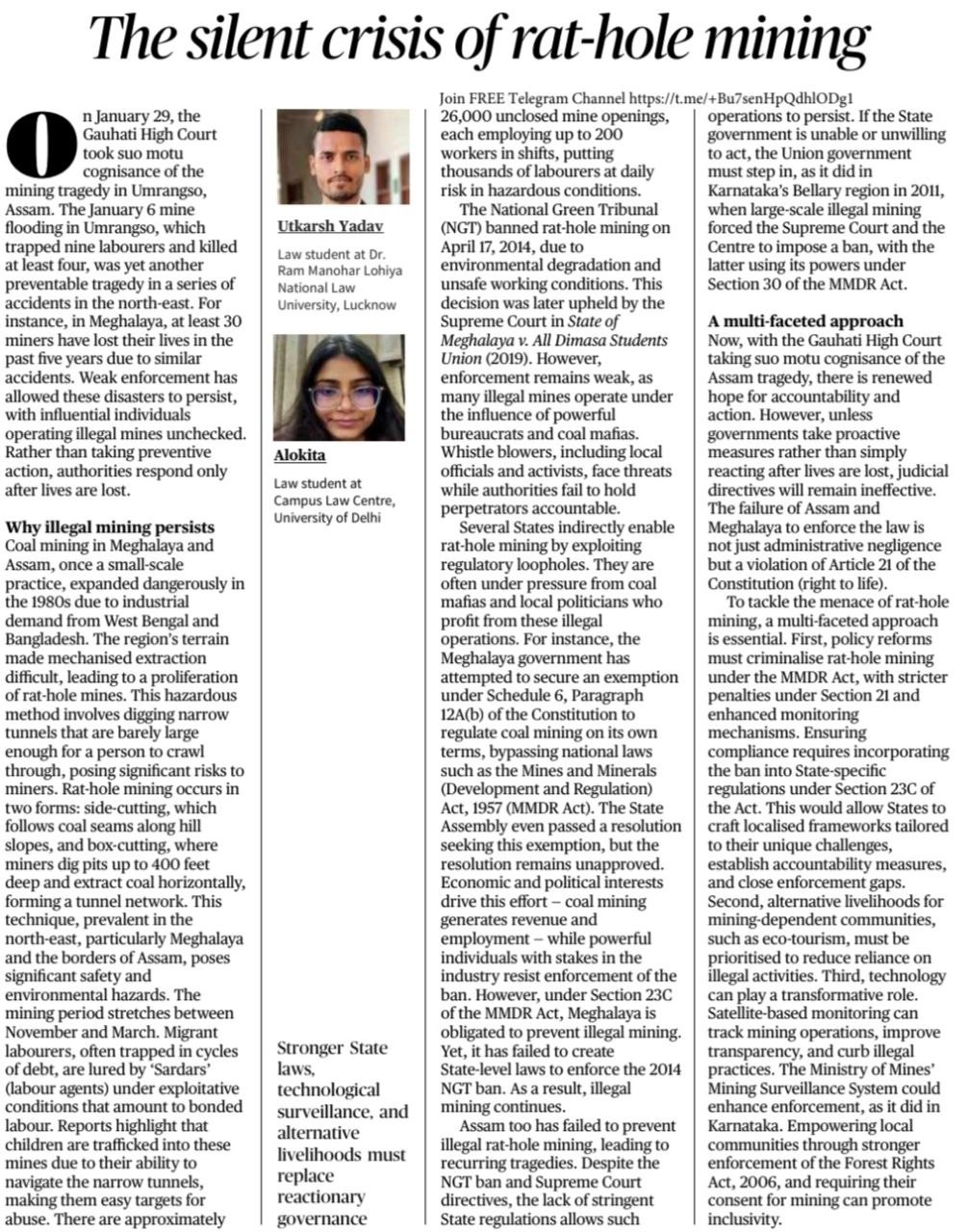1. The Hidden Crisis of Rat-Hole Mining
Introduction
Rat-hole mining, a hazardous and illegal practice, persists in states like Meghalaya and Assam despite judicial bans. The recent mining tragedy in Umrangso, Assam, highlights the continued exploitation of laborers, environmental degradation, and weak enforcement of mining regulations.
Why Rat-Hole Mining Persists
- Economic Incentives
- Coal mining is a major economic activity in Meghalaya and Assam.
- It provides employment and revenue, leading to political support.
- Illegal Operations and Weak Enforcement
- Despite bans by the National Green Tribunal (NGT) in 2014 and Supreme Court rulings, illegal mining continues.
- Weak enforcement allows influential individuals to evade accountability.
- Exploitation of Migrant Labourers and Children
- Many laborers, including children, work under hazardous conditions.
- Trafficking of children into mines due to their ability to navigate narrow tunnels.
- Lack of Alternative Livelihoods
- Communities dependent on mining resist legal bans due to the absence of alternative employment.
Challenges in Implementation of the Ban
- Meghalaya government sought exemptions under the Constitution, bypassing national laws.
- Political and economic pressures weaken enforcement mechanisms.
- Satellite-based tracking and better enforcement are not yet fully implemented.
Way Forward: A Multi-Faceted Approach
- Stronger Legal and Technological Enforcement
- Stricter penalties under the Mines and Minerals (Development and Regulation) Act.
- Use of satellite-based monitoring and improved surveillance.
- Empowering Local Communities
- Strengthen enforcement of the Forest Rights Act, 2006.
- Encourage eco-tourism and sustainable livelihoods.
- Judicial Accountability and Governance
- Strict accountability measures for officials failing to act.
- Close enforcement gaps with proper regulation and monitoring.
Conclusion
Rat-hole mining remains a major issue despite legal bans. Stronger state laws, technological interventions, and alternative livelihoods must replace reactionary governance. Without proactive measures, the cycle of illegal mining, environmental degradation, and human exploitation will continue.
Bottom of FormMains Practice Question |
Q. “Despite judicial bans, rat-hole mining continues in India, causing severe socio-economic and environmental impacts.” Critically analyze the reasons for its persistence and suggest a multi-pronged strategy to tackle it. |
2. Revitalizing the Panchayati Raj System in India
Introduction
The 73rd Constitutional Amendment Act, 1992, was a landmark reform to institutionalize grassroots democracy through Panchayati Raj institutions (PRIs). However, in recent years, the movement has lost momentum due to administrative, political, and financial challenges. Technological advancements and urbanization have further sidelined PRIs, making their revival crucial for local governance.
Achievements of Panchayati Raj System
- Democratic Decentralization – Strengthened local governance with a three-tier structure.
- Increased Political Representation – 50% reservation for women, SCs, and STs.
- Empowerment through Funds, Functions, and Functionaries – Devolution of power and local planning.
- Implementation of Social Sector Schemes – Key role in rural development programs.
Challenges in the Panchayati Raj System
- Lack of Financial Autonomy
- States have not fully implemented fiscal devolution.
- Increased reliance on central grants, weakening independent functioning.
- Administrative and Political Hindrances
- Panchayats face bureaucratic interference and political centralization.
- State governments tend to dominate local decision-making.
- Urbanization and Changing Priorities
- Migration and urban expansion shift focus away from rural governance.
- More financial and administrative resources are directed towards municipalities.
- Technology and Direct Benefit Transfers (DBT)
- JAM (Jan Dhan-Aadhaar-Mobile) trinity and DBT have reduced the role of panchayats in welfare schemes.
- Centralized schemes like PM-KISAN bypass PRIs in fund allocation.
Ways to Strengthen Panchayati Raj Institutions
- Enhancing Financial Autonomy
- Proper devolution of funds through State Finance Commissions.
- Increased revenue-generation capacity for PRIs.
- Technological and Administrative Reforms
- Digital integration for better governance and accountability.
- Strengthening local participation in planning and decision-making.
- Role in Rural Development
- PRIs must be integrated into climate-resilient agriculture, renewable energy, and skill-based employment.
- Strengthening local governance to bridge the rural-urban divide.
- Political Empowerment and Reforms
- Reducing excessive bureaucratic control over Panchayati Raj bodies.
- Encouraging participatory governance at the grassroots level.
Conclusion
The Panchayati Raj system needs urgent revitalization to remain relevant in India’s governance framework. Strengthening financial, administrative, and political decentralization is essential for empowering PRIs. As India urbanizes, PRIs should evolve to play a greater role in inclusive and sustainable rural development.
Mains Practice Question |
Q. “The Panchayati Raj system in India is losing its relevance due to urbanization, technological changes, and centralized governance.” Critically examine the challenges faced by PRIs and suggest measures to strengthen them. |



